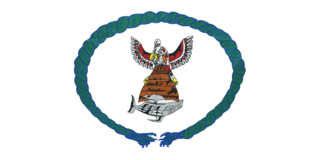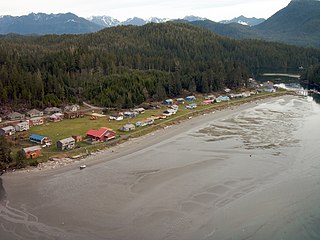Related Research Articles

The Nuu-chah-nulth, also formerly referred to as the Nootka, Nutka, Aht, Nuuchahnulth or Tahkaht, are one of the Indigenous peoples of the Pacific Northwest Coast in Canada. The term Nuu-chah-nulth is used to describe fifteen related tribes whose traditional home is on the west coast of Vancouver Island.

The Tla-o-qui-aht First Nations are a Nuu-chah-nulth First Nation in Canada. They live on ten reserves along the Pacific Rim National Park Reserve on Vancouver Island, British Columbia. The band is part of the Nuu-chah-nulth Tribal Council. There were 618 people living in the Tla-o-qui-aht reserves in 1995. Their primary economic activities are fishing and tourism.
Nuu-chah-nulth, a.k.a.Nootka, is a Wakashan language in the Pacific Northwest of North America on the west coast of Vancouver Island, from Barkley Sound to Quatsino Sound in British Columbia by the Nuu-chah-nulth peoples. Nuu-chah-nulth is a Southern Wakashan language related to Nitinaht and Makah.

Tseshaht First Nation is an amalgamation of many tribes up and down Alberni Inlet and in the Alberni Valley of central Vancouver Island in the Canadian province of British Columbia. They are a member of the Nuu-chah-nulth Tribal Council which includes all other Nuu-chah-nulth-aht peoples except the Pacheedaht First Nation.

Northwest Coast art is the term commonly applied to a style of art created primarily by artists from Tlingit, Haida, Heiltsuk, Nuxalk, Tsimshian, Kwakwaka'wakw, Nuu-chah-nulth and other First Nations and Native American tribes of the Northwest Coast of North America, from pre-European-contact times up to the present.
The Nuu-chah-nulth Tribal Council is a First Nations Tribal Council in the Canadian province of British Columbia, located on the west coast of Vancouver Island. The organization is based in Port Alberni, British Columbia.

The Ahousaht First Nation is a First Nation government based on the west coast of Vancouver Island in British Columbia, Canada. It administers the community of Ahousaht, British Columbia, which encompasses much of Clayoquot Sound. The Ahousaht are a member of the Nuu-chah-nulth Tribal Council. It is led by Chief A-in-chut Shawn Atleo and the Taayi Haw̓ił - Maquinna.

The Ehattesaht First Nation is a First Nations government covering about 660 km^2 on the West Coast of Vancouver Island in the British Columbia, Canada. It is a band that is one of the 14 Nuu-Chah-Nuulth Nations and is now a member of the Nuu-chah-nulth Tribal Council. In the modern-day, there are currently only 539 registered members as of October 2021. with a language that has been lost over the years as the British Columbia government states that there are only 52 speakers of the language.

Joe David is a Nuu-chah-nulth artist, a member of the Tla-o-qui-aht Band of the Nuu-chah-nulth people, also formally "adopted" into the Haida people, whose work is identified with the contemporary Northwest Coast art movement; among his close associates are teacher and art historian Bill Holm, Duane Pasco, and his cousin Ron Hamilton. He is also a singer of traditional Nuu-chah-nulth songs, and has a strong interest in shamanic traditions, both those from his own culture and from others.

Opitsaht, spelled also as Opitsat and Opitsitah, is a Tla-o-qui-aht settlement/community in the Southwest area of the Meares Islands, Clayoquot South, British Columbia. This peninsula-like region is the home to the Tla-o-qui-aht people from the Nuu-chah-nulth nation, a tribe from the Pacific Northwest region in the lower Vancouver area, known for their lifestyle revolving around the marine life trade and culture within the community.
The following is an alphabetical list of topics related to Indigenous peoples in Canada, comprising the First Nations, Inuit and Métis peoples.

The Battle of Woody Point was an incident in western Canada in June 1811 involving the Tla-o-qui-aht natives of the Pacific Northwest and the Tonquin, an American merchant ship of the Astor Expedition. The vessel had traveled to Clayoquot Sound off Vancouver Island to trade for furs. Following an argument begun during the bartering, the Tla-o-qui-aht captured the vessel and massacred most of the crew; one remaining sailor then scuttled her by detonating the powder magazine.
Ron Hamilton may refer to:

The Clayoquot protests, also called the War in the Woods, were a series of blockades related to clearcutting in Clayoquot Sound, British Columbia. They culminated in mid-1993, when 856 people were arrested. The blockades in the summer of 1993 against logging of the temperate rainforest were the largest act of civil disobedience in Canadian history until the 2021 Fairy Creek blockades.

The Yuquot Whalers' Shrine, previously located on Vancouver Island, British Columbia, was a site of purification rituals, passed down through the family of a Yuquot chief. It contained a collection of 88 carved human figures, four carved whale figures, and sixteen human skulls. Since the early twentieth century, it has been in the possession of the American Museum of Natural History in New York City, but is rarely displayed. Talks are underway regarding repatriation.

Benson Island, known to the Tseshaht First Nation people as C'isaa (Ćišaa?atḥ) or Ts'ishaa (Ts'isha?atH), is part of the Broken Group in Barkley Sound on the west coast of Vancouver Island, British Columbia, Canada. It is notable because the Tseshaht First Nation recognize it as the creation site where the first man and first woman of the Tseshaht people came into this world.
Martha Black was a Canadian art historian who specialized in Northwest Coast art and issues in museum management and repatriation. Black authored a number of articles and a book on Heiltsuk and Nuu-chah-nulth art, and issues related to repatriation outside of the treaty process. She was the curator of the Indigenous Collection at the Royal British Columbia Museum.

Whaling on the Pacific Northwest Coast encompasses both aboriginal and commercial whaling from Washington State through British Columbia to Alaska. The indigenous peoples of the Pacific Northwest Coast have whaling traditions dating back millennia, and the hunting of cetaceans continues by Alaska Natives and to a lesser extent by the Makah people.
Connie Watts is a mixed media artist and designer of Nuu-chah-nulth, Gitxsan and Kwakwaka'wakw ancestry. She lives and works on Coast Salish territory in Port Alberni and West Vancouver.
Samuel Haiyupis is a Nuu-chah-nulth artist from Ahousaht, British Columbia. The Canadian Museum of History has one of his carvings on display in its Grand Hall.
References
- ↑ Thom, Ian M. (2009). Challenging Traditions: Contemporary First Nations Art of the Northwest Coast. Douglas & McIntyre. ISBN 9781553654148.
- ↑ "2010 Cultural Olympiad opening the curtain on aboriginal art". 20 January 2010.
- ↑ http://www.newswire.ca/fr/releases/archive/September2009/21/c6925.html [ dead link ]
- ↑ "Ron (Ki-Ke-In) Hamilton (1948- ), Nuu-chah-nulth artist biography and portfolio". Spirit Wrestler Gallery. Retrieved 2018-01-12.
- ↑ "Nuu-chah-nulth culture displayed in D.C. | Ha-Shilth-Sa Newspaper". 18 December 2012.
- ↑ "B.C. Nuu-chah-nulth artist named co-curator of NYC museum restoration project | CBC News".